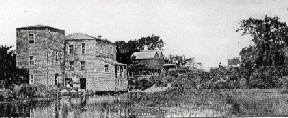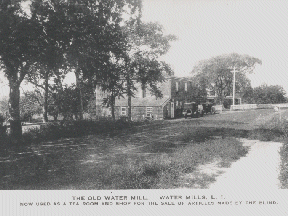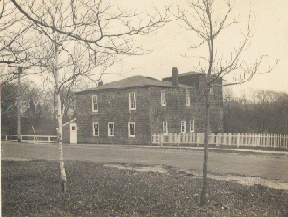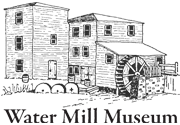The history of the water mill begins with Edward Howell who came to Southampton, Long Island in 1640 with English colonists from Lynn, Massachusetts. Howell had owned a water mill on a pond in Lynn so it was not surprising that he settled on a 100-acre pond three miles from Southampton for his new venture.
Howell – the wealthiest citizen of the new colony and its magistrate – got the town to give him 40 acres on the pond and to provide labor and money to support his project. The mill was built and millstones hewn from two boulders found in the moraine north of the site. Oral history places this first mill, which was probably grinding by 1644, several hundred yards north of its current site on Mill Creek.
In 1726, and again in 1790, permission was granted by the town to move the mill south and build a combination dam/roadway at its present location. There’s no record indicating whether the mill was moved intact or if parts were used to construct a new mill – but the latter is considered most likely. The original mill may have had an overshot wheel but at the new site an undershot wheel was used. Evidence uncovered in the basement of the mill suggests that at sometime in its operation a horizontal tub water wheel was in use.

The Water Mill
The mill passed through many families. William Ludlam Sr. was the owner of the mill by 1653 and it remained in his family for over one hundred years. Elias Petty, William Foster, Hugh Smith, Jesse Hedges and John White were also owners who used water-power to weave, full cloth and manufacture paper.
In 1819, John Benedict, a fuller, dyer and dresser of cloth, came to Water Mill to work at the mill. He acquired ownership by 1833. The Benedict family in the 1800s used the building for fulling wool cloth, dyeing, spinning, weaving and milling grain

The Water Mill
By the early 1900s the building had fallen into disuse. A women’s group, The Ladies Auxiliary of Water Mill, began in 1921 to annually lease the building and make necessary repairs. Twenty-one years later they owned the mill and in 1968 began the process of restoring it as a museum. In 1976, after years of research, fund-raising and reconstruction, the historic water-powered grist mill was grinding once again.

The Water Mill 1960
The maintenance of the old water mill that named the hamlet has required major funds and volunteer labor. This has been generously donated by Water Mill residents and others who appreciate this historic building which is one of the oldest commercial buildings on Long Island.
